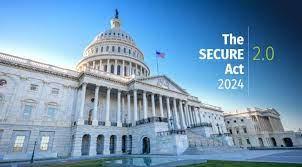
2024 Implementation of SECURE Act 2.0
You may recall news stories (and my blog posts in January and February) in early 2023 about SECURE Act 2.0. This legislation updated some laws that govern mostly retirement savings accounts but also other types. Some changes were effective for 2023 while others delayed until 2024 and later. This blog post will discuss the 2024 features now in effect. I will also briefly mention features that went in effect last year and what is coming in 2025 and beyond.
Brief summary of key features that were effective for 2023
- Required Minimum Distribution (RMD) starts at age 73 (extend to 75 in 2033)
- Reduce penalty for missed RMDs from 50% down to 25%; down to 10% if fixed on a timely basis
- Increased Qualified Longevity Annuity Contract (QLAC) amount up to $200k; no 25% limit
- Employer can make matching contributions to Roth if participant wishes (and if plan updated!)
- Can have Roth option in SIMPLE and SEP plans (but custodians are not ready!)
- Sole proprietor with new plan can make salary deferral contributions for prior year
One feature originally schedule for 2024 but now delayed until 2026
- 401k catch-up contributions must go to Roth 401k if wages > $145,000
- Based on previous year wages of individual from that employer; can avoid if switch jobs
- If 401k plan doesn’t have Roth 401k option won’t be able to make catch-up… interesting
Here are key features effective for 2024
- Excess savings in 529 – up to $35,000 - can be used for Roth contributions for beneficiary
- A “hot” item but still waiting for clarity on some details
- Main uncertainty – does a change in beneficiary impact 15-year rule (I assume does)
- 529 open for at least 15 years and can’t use contributions or earnings from last 5 years
- Recipient must have compensation and subject to annual IRA contribution limit across all IRAs, but NOT restricted by income limit like regular Roth IRA contributions
- Also note this is a Federal law; some states don’t allow this as “qualified distribution” and state tax benefits will be lost (IL does not allow as “qualified”).
- No RMDs for Roth 401k
- RMDs were never required for Roth IRAs; ARE REQUIRED for Beneficiary Roth IRAs
- IRA catch-up contribution limits indexed to inflation in $100 increments
- Those age 50+ currently can contribute extra $1,000 to IRAs
- Unfortunately there is no adjustment for 2024 but at least the meter is running
- Maximum allowed for Qualified Charitable Distribution (QCD) indexed to inflation
- $105,000 allowed for 2024; was $100,000 for 2023 and years prior
- Age 70.5+ (not 73!) to make charitable donation from IRA; counts as RMD but not taxed
- Surviving spouse can choose decedent’s age for RMDs
- Benefit if survivor is older – either delay start of RMD or use higher factors => less RMD
- Roth 401k Emergency Fund
- Can contribute up to $2,500 in total (highly compensated not eligible)
- Held in cash-like instruments; plans need to allow; distribution questions remain
- Additional SIMPLE IRA employer contributions (for 2024 tax year plans, not 2023)
- Beyond required match, up to lesser of $5,000 or 10% of compensation
- Employer can match participants’ student loan payments as if was salary deferral
- Matching and vesting schedule must be same as regular salary deferral
More excitement for 2025 or later
- RMD at age 75 starting in 2033
- Extra catch-up contribution for those age 60 – 63 starting in 2025
- For 401k, limited to $10,000 or 150% of regular catch-up that year
- For SIMPLE IRA, limited to $5,000 or 150%
- IRA withdrawal without penalty to cover Long-Term Care insurance premiums starting 12/29/25
- Limited to lesser of $2,500 or 10% of balance
- Expand ABLE account eligibility to person disable before age 46, not current 26, starting in 2026
- ETFs can be used in variable life and variable annuities starting 12/29/2029
- Mandatory Auto Enrollment starting 2025 (participant can opt out)
- Initial rate from 3% - 10%; auto increase 1%/year until 10% - 15%
- Plans exempt: existing, govt, church, under 10 employees, SIMPLE
Be sure to utilize tax-qualified savings to enhance your retirement savings power. These latest implementation rules may seem daunting but I encourage their use if appropriate for your circumstances. Reach out for help to maximize the benefits available.
Posted by Kirk, a fee-only financial advisor who looks at your complete financial picture through the lens of a multi-disciplined, credentialed professional. www.pvwealthmgt.com

